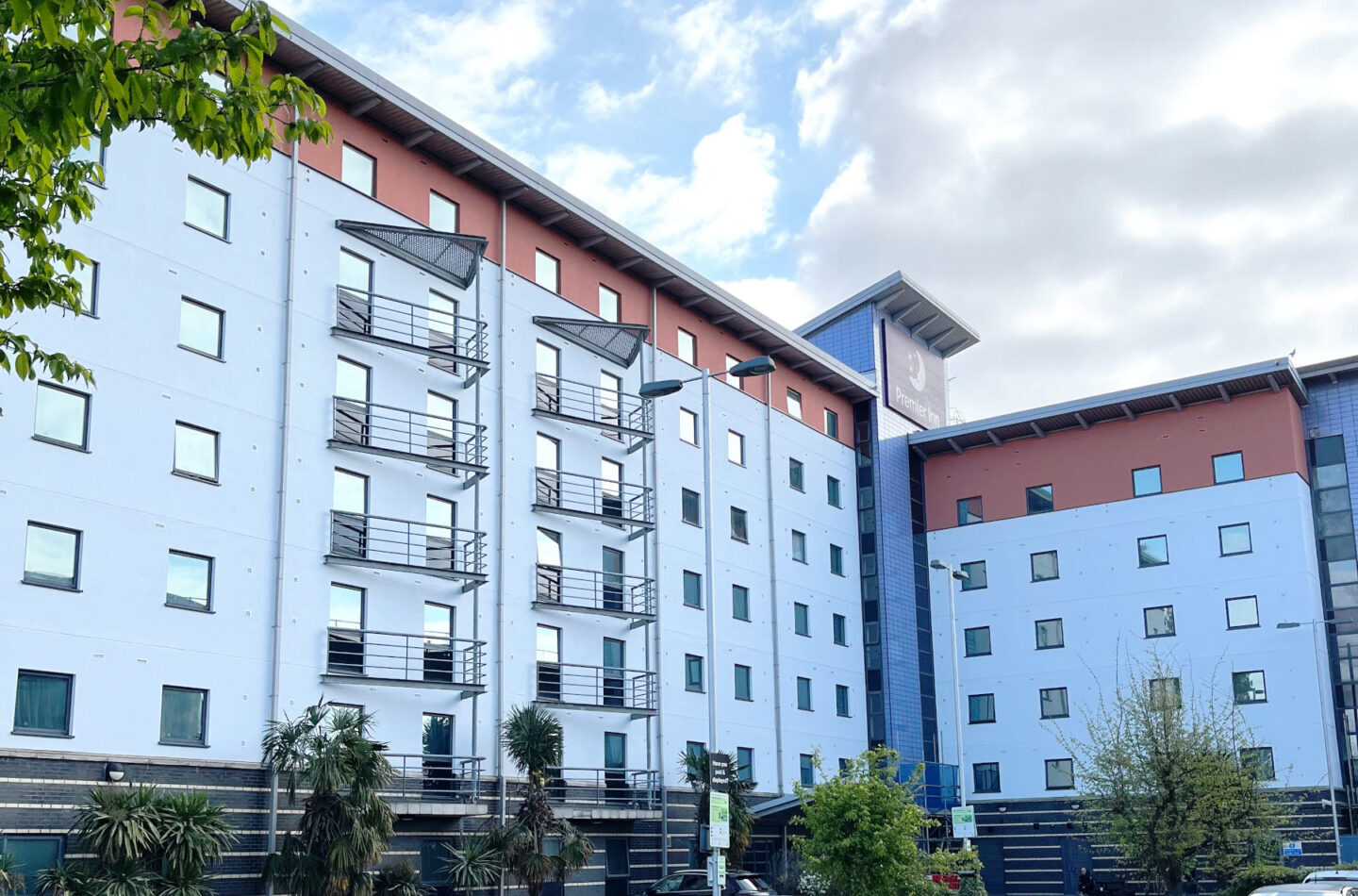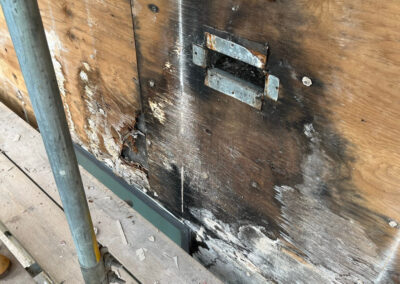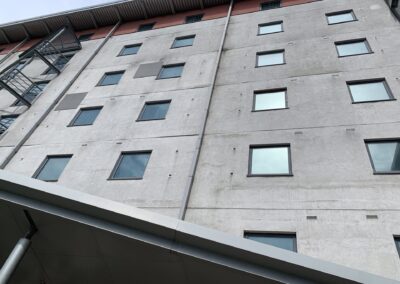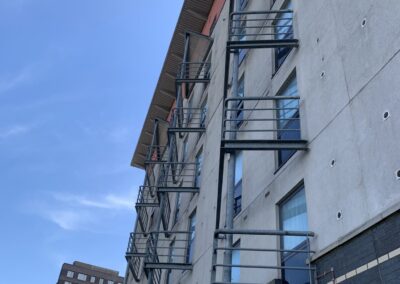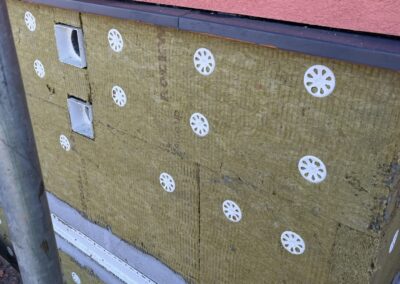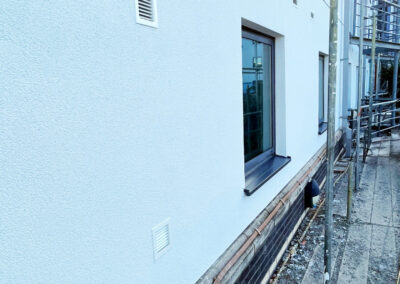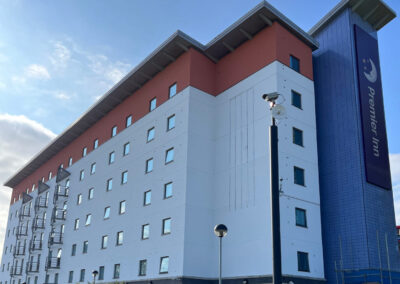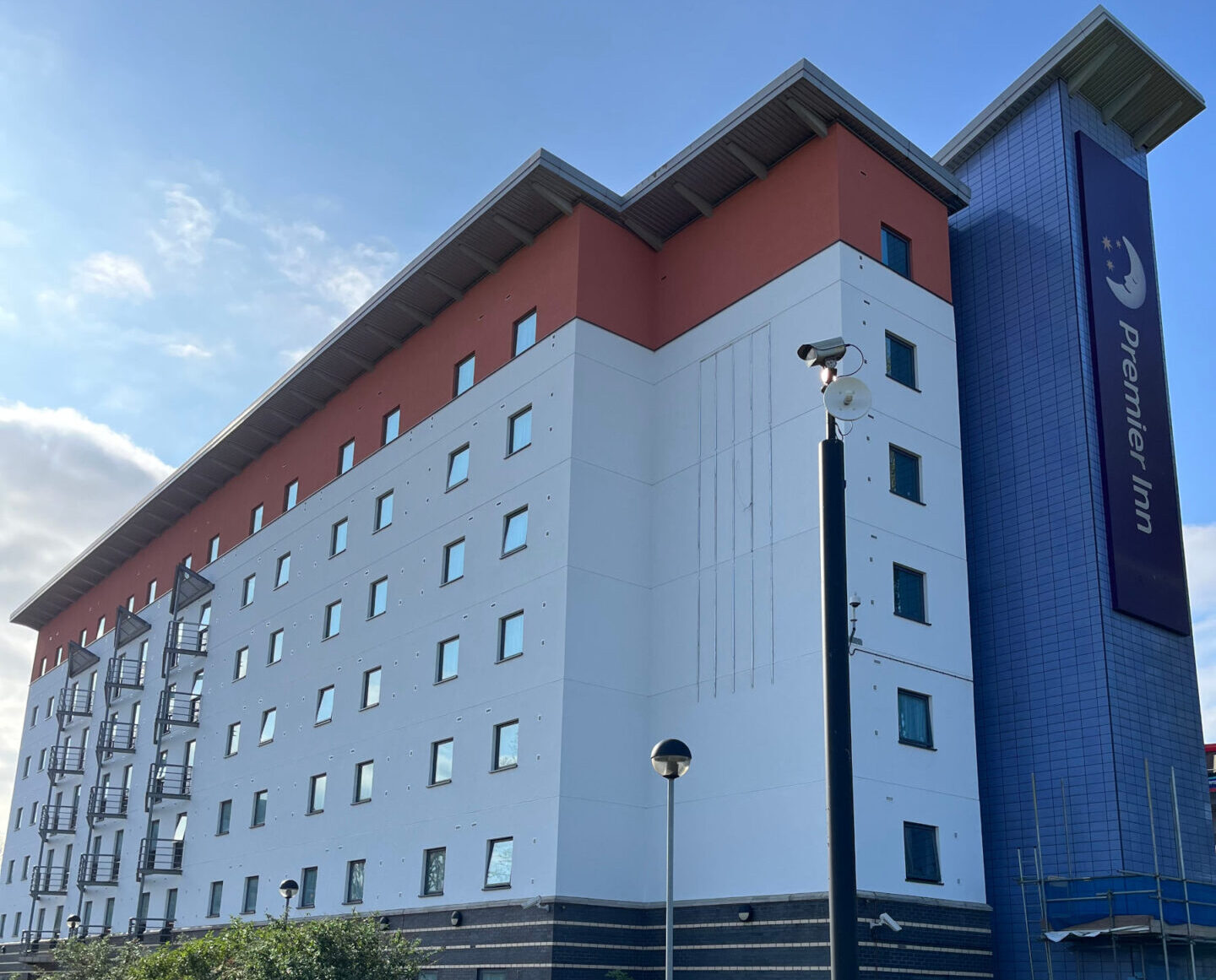INCA Case Study: Premier Inn, London Docklands
Premier Inn Docklands
 Project Type: Refurbishment
Project Type: Refurbishment
Building Type: High Rise, Non-Residential
Architect: Axiom Architects
System Designer: PermaRock Products Limited
Installer: PJ Mear Ltd.
System & Finish: PermaRock MF system & Silicone Ultra K
U-value Before: 0.3 W/m2k
U-value Achieved: 0.29 W/m2k
Project Background:
This scheme featured a popular waterfront Premier Inn hotel set close to the ExCeL Centre and London City Airport. It is a seven-storey, timber-framed building that features balconies and brise soleil sunshades. The ground floor is brick-built and the levels above it originally featured a mineral wool insulation and render system.
In 2022, the owner Whitbread commissioned a re-insulation and recladding project because the existing system was found to have failed. The brief required that the replacement system should replicate the colours and appearance of the original design and, given the height of the building – over 11 metres – it would also need to be fire-safe.
A2O was appointed as main contractor and PJ Mear selected as the specialist installer.
Specification and Installation:
The replacement of the old mineral wool insulation system began after the completion of remedial works to the timber frame. Water ingress had led to localised problems – e.g. swelling timbers and, in some cases, loose blockwork. The problem had arisen because movement joints within the substrate had not been replicated through the original cladding system and, where it had flexed and buckled, water had penetrated.
The architect, Axiom, specified a system comprising PermaRock Mineral Fibre insulation in various thicknesses, together with PermaRock’s Silicone Ultra K Finish. PJ Mear took responsibility for applying the system over RCM Y-Wall sheathing board, plus all the associated adaptations.
On the first floor, a thicker (110 mm) board was used. This was because it featured very heavy-duty steel frame reinforcement that projected almost 80 mm from the main façade. In order to enclose the frames within the external wall insulation system, and to maintain a flat façade, the boards needed to be thick enough to accommodate deep and carefully cut rebates. Given the various practical demands upon the system – e.g. robustness, safe fixing etc. – this was only feasible with a thicker board.
On the top floor, 50 mm dual-density rockwool insulation boards were used, installed beneath the self-cleaning silicone finish. This was supplied in a special colour – Cameo 135 – to match the appearance of the original. In all, this system was applied to 400 m2 of walls.
Over four of the five storeys beneath that, PJ Mear used an 80 mm EWI system, installed beneath another special colour: Lazur 60. The use of these colours and the 1.5 mm aggregate render ensured that the appearance of the finished project closely matched the building’s established design. In total, the system covered an area of 1600 m2 on the lower storeys.
In all cases, the combined external wall insulation systems met the requirements for use on buildings with a height of over 11 metres. They have all been shown in tests to achieve an excellent reaction to fire performance, and an A2-s1,d0 classification in accordance with BS EN 13501-1:2007+A1:2009.
Design / Technical Challenges
It was only when the failed system was removed that the problem of loose blockwork became apparent, and this clearly demanded changes to the refurbishment programme and to the EWI specification. It was evident that the first floor would require extensive brick and blockwork repairs to the single-skin lightweight blockwork façade. It would also require the installation of heavy structural steel to make the façade sufficiently strong to resist wind loads and to support the weight of the EWI system without causing any structural issues behind the system.
The preparation of insulation boards for this challenging first floor required painstaking work, including creating rebates to very tight tolerances. However, excellent collaboration with the system designer’s technical team enabled PJ Mear to manage all the complex detailing and to complete the installation to a very high standard. (See photos and feedback from main contractor, hereafter.)
The brise soleils presented another challenge, as did the presence of extract vents from every guest room. They required not only complex detailing in their own right; many of the details also coincided with the horizontal movement joints, which had to be preserved in order to ensure that the new EWI system would remain unaffected by any further movement in the building.
Part of the solution, devised by A20 with the system designer’s assistance, entailed the creation of telescopic ducting that could be built into the system. The project demanded considerable design input and muti-partner stakeholder discussions but, in the event, the solution worked very well. All the necessary services and ventilation were maintained without compromising the performance of the system or the aesthetics of the finish, and all while the building remained occupied.
An Unforeseen Challenge
During the scheme, PJ Mear faced an additional and unexpected challenge. Unrelated civil engineering works at the nearby ExCeL Centre caused a rupture in the mains water system and this, in turn, caused a localised flood. Installers arrived to find the site compound under two feet of water, which had caused damage to stocks of insulation boards and base coat.
PJ Mear preserved what it could by moving any surviving material stocks and/or jacking them up on pallets. This enabled work to continue while replacement materials were quickly re-ordered. Flexible programming and close collaboration with PermaRock (i.e. the British system manufacturer) ensured that work could continue at pace, and that new materials were delivered quickly, minimising risks of project delays.
Thermal Performance Enhancement
Following early design meetings with the architect, 16 different sets of U-value calculations were performed to offer the architect various options. They assessed the efficiency of the property as it was, and the expected improvements achieved by different variations of the new mineral fibre system. The most recent calculations for the ‘before and after’ conditions for the main wall type produced results as follows:
- As per existing building: U=0.3 W/m²K
- As per main wall, after re-insulation: U=0.29 W/m²K
Results:
The objective was to install a hard-wearing system with properly installed movement joints, while also preserving the original appearance of the building, and either matching or improving upon the performance of the system that had been removed. Moreover, this all had to be done under difficult environmental conditions, over winter, and while having to observe stringent noise controls and seeking to minimise disruption to hotel staff and guests. In the event, all those objectives were achieved.
Hotel staff were able to continue their usual work throughout the scheme. PJ Mear installers worked hard, collectively and flexibly to maximise productivity and to hand over what was ultimately a first-class system. The project was delivered without a single snag and with a zero-defect record.
Stakeholder Feedback
PJ Mear’s client, the main contractor A20, made numerous positive remarks about the quality of the finish during and after the project.
A2O managing director Martin Coupe said:
“A key challenge with any re-cladding project is dealing with the unknown; being sufficiently flexible, capable and proactive to deal with the unforeseeable issues that only become apparent when the façade is stripped away. This is something that PJ Mear did very well. They not only delivered on the main objective to install the EWI system but they also had the skills and confidence to manage the remediation to the blockwork superstructure. It was an excellent result, managed very competently.”
PJ Mear not only delivered on the main objective to install the EWI system but they also had the skills and confidence to manage the remediation to the blockwork superstructure. It was an excellent result, managed very competently.

